Analyzing Workplace Transformation Impact on Nissan's Productivity
VerifiedAdded on 2023/06/12
|32
|7637
|288
Report
AI Summary
This report investigates the impact of workplace transformation on Nissan's productivity. The study employs a qualitative research approach, gathering data from 30 managerial employees. Findings indicate a direct and significant positive correlation between workplace transformation and organizational productivity. The report covers various themes, including the concept of workplace transformation, its impact on organizational productivity, and the challenges associated with its implementation. It also delves into research methodologies, data analysis, and ethical considerations. Ultimately, the report concludes with recommendations for effective workplace transformation strategies to enhance productivity within organizations like Nissan. Desklib provides access to this and other student-contributed assignments.
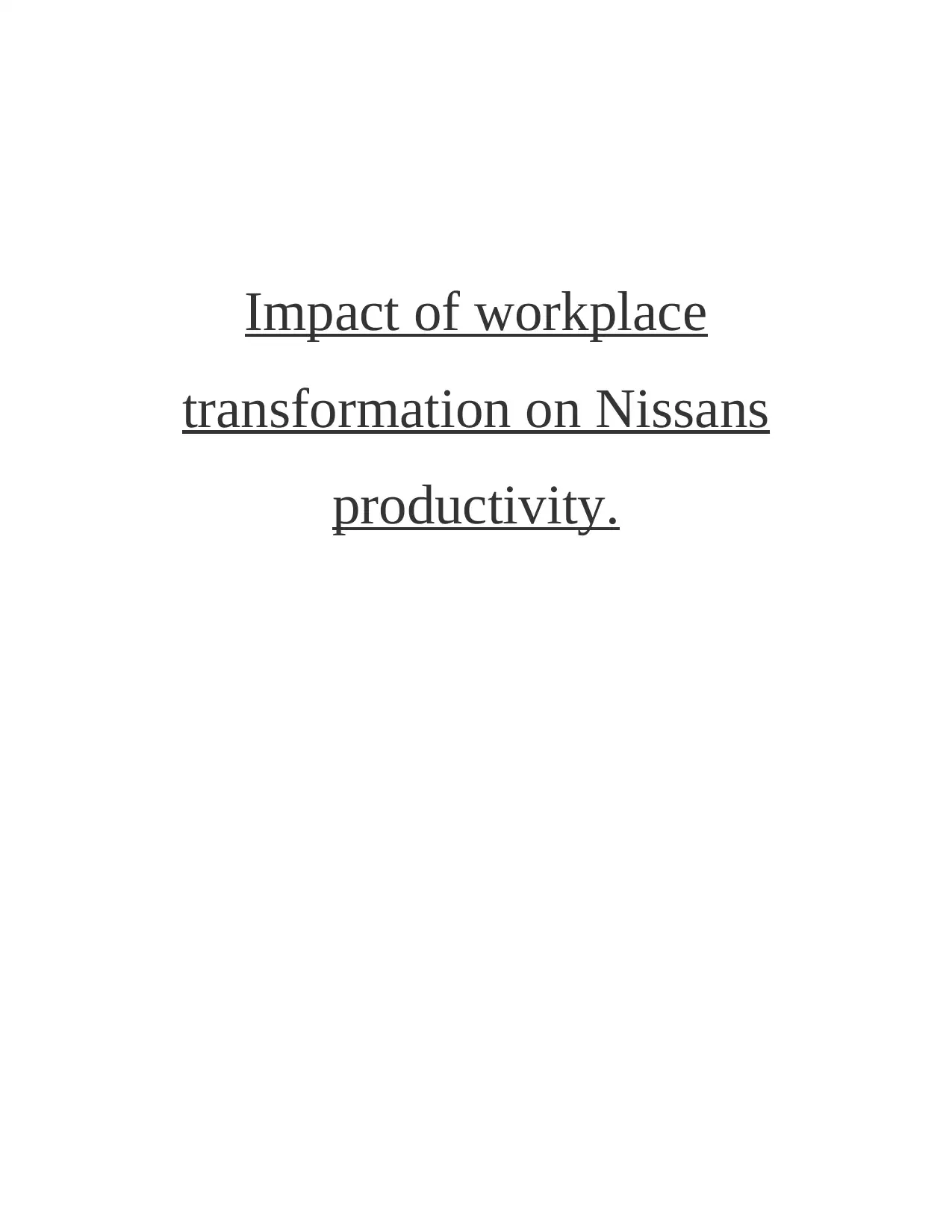
Impact of workplace
transformation on Nissans
productivity.
transformation on Nissans
productivity.
Paraphrase This Document
Need a fresh take? Get an instant paraphrase of this document with our AI Paraphraser
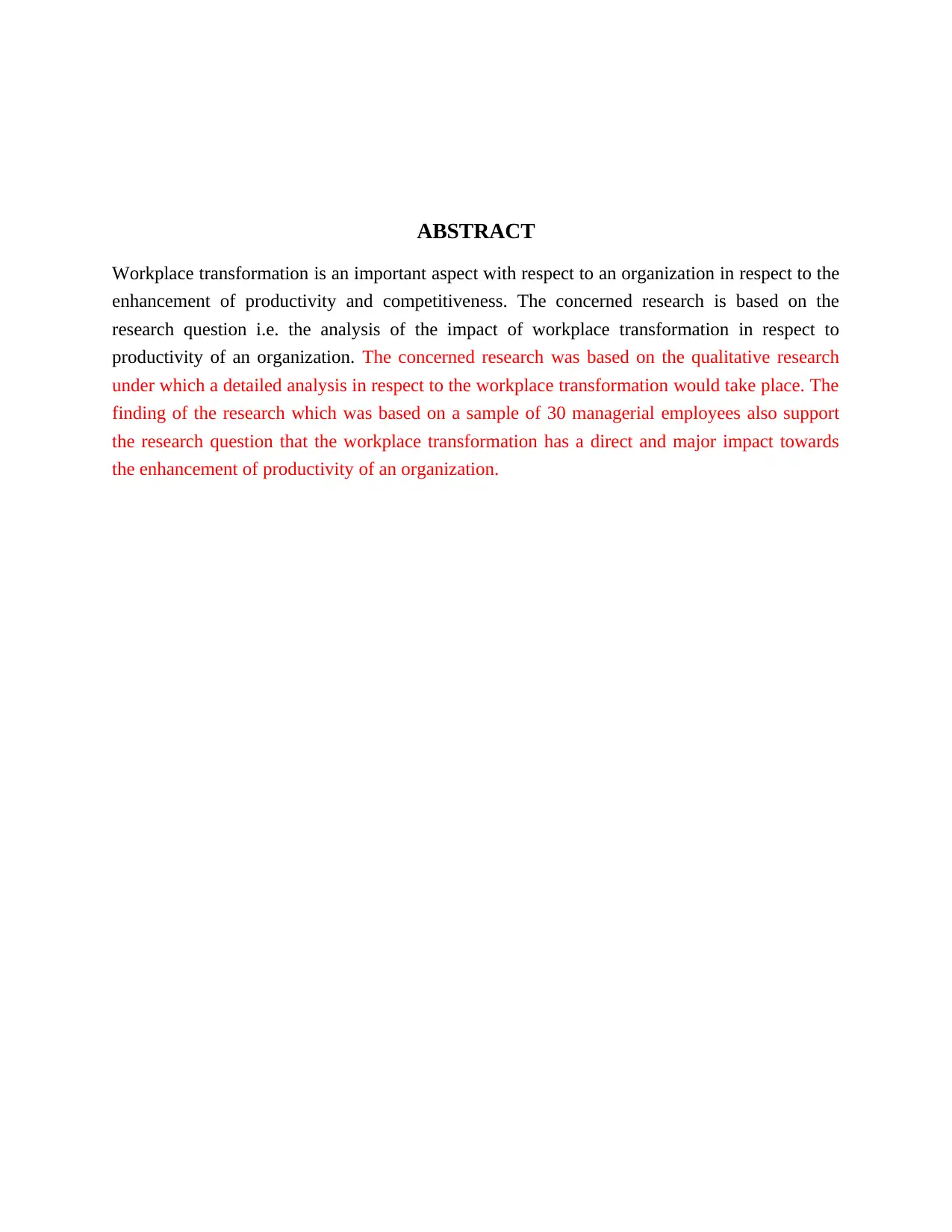
ABSTRACT
Workplace transformation is an important aspect with respect to an organization in respect to the
enhancement of productivity and competitiveness. The concerned research is based on the
research question i.e. the analysis of the impact of workplace transformation in respect to
productivity of an organization. The concerned research was based on the qualitative research
under which a detailed analysis in respect to the workplace transformation would take place. The
finding of the research which was based on a sample of 30 managerial employees also support
the research question that the workplace transformation has a direct and major impact towards
the enhancement of productivity of an organization.
Workplace transformation is an important aspect with respect to an organization in respect to the
enhancement of productivity and competitiveness. The concerned research is based on the
research question i.e. the analysis of the impact of workplace transformation in respect to
productivity of an organization. The concerned research was based on the qualitative research
under which a detailed analysis in respect to the workplace transformation would take place. The
finding of the research which was based on a sample of 30 managerial employees also support
the research question that the workplace transformation has a direct and major impact towards
the enhancement of productivity of an organization.
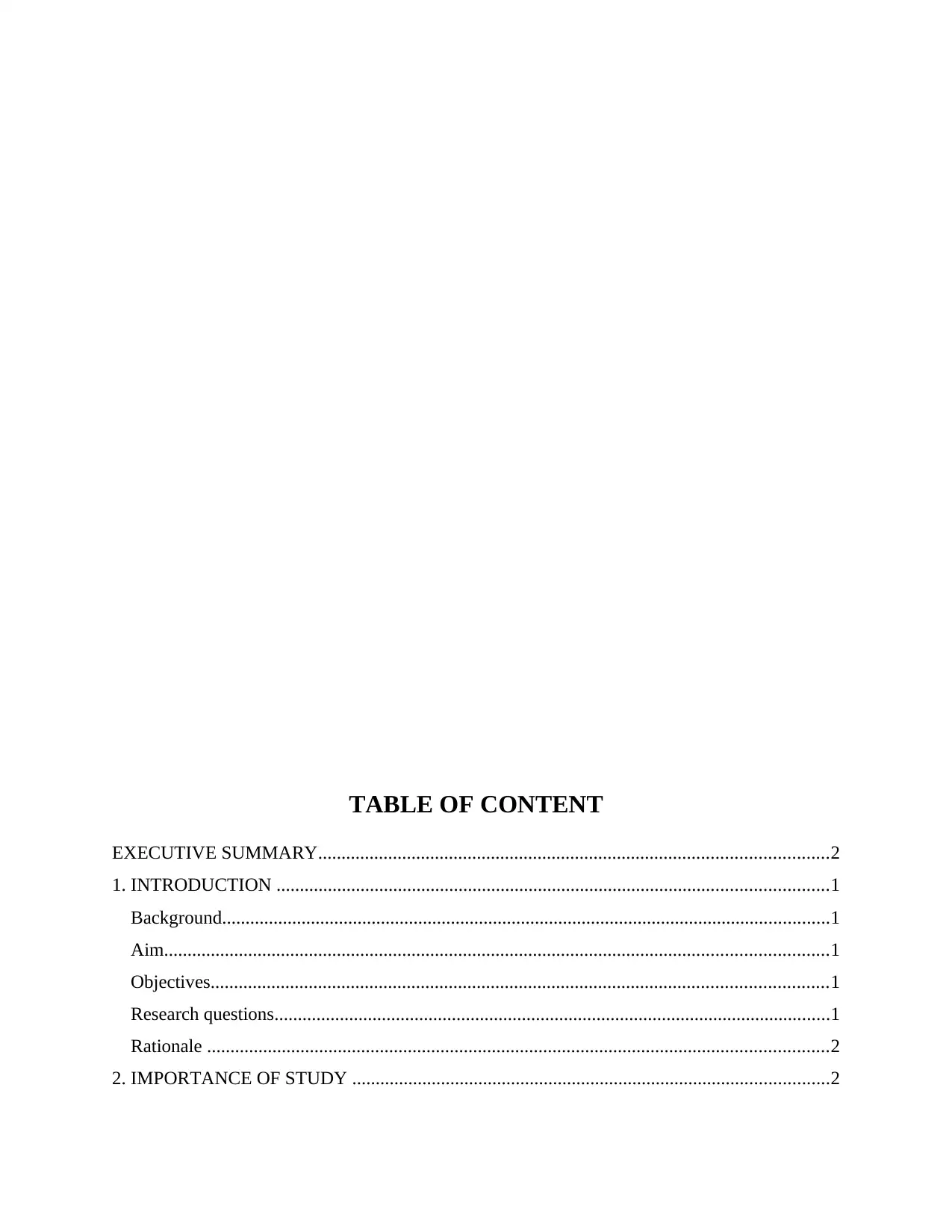
TABLE OF CONTENT
EXECUTIVE SUMMARY.............................................................................................................2
1. INTRODUCTION ......................................................................................................................1
Background..................................................................................................................................1
Aim..............................................................................................................................................1
Objectives....................................................................................................................................1
Research questions.......................................................................................................................1
Rationale .....................................................................................................................................2
2. IMPORTANCE OF STUDY ......................................................................................................2
EXECUTIVE SUMMARY.............................................................................................................2
1. INTRODUCTION ......................................................................................................................1
Background..................................................................................................................................1
Aim..............................................................................................................................................1
Objectives....................................................................................................................................1
Research questions.......................................................................................................................1
Rationale .....................................................................................................................................2
2. IMPORTANCE OF STUDY ......................................................................................................2
⊘ This is a preview!⊘
Do you want full access?
Subscribe today to unlock all pages.

Trusted by 1+ million students worldwide
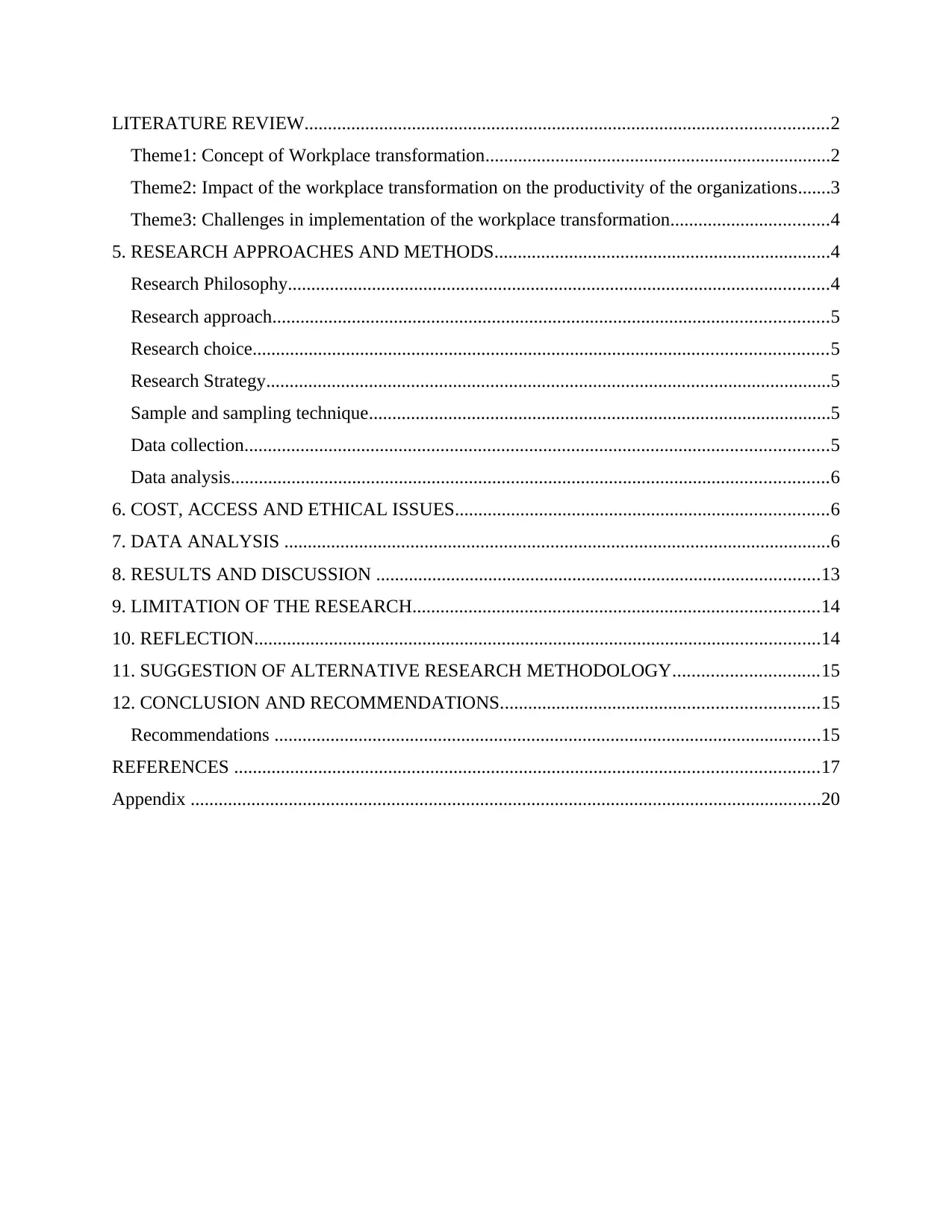
LITERATURE REVIEW................................................................................................................2
Theme1: Concept of Workplace transformation..........................................................................2
Theme2: Impact of the workplace transformation on the productivity of the organizations.......3
Theme3: Challenges in implementation of the workplace transformation..................................4
5. RESEARCH APPROACHES AND METHODS........................................................................4
Research Philosophy....................................................................................................................4
Research approach.......................................................................................................................5
Research choice...........................................................................................................................5
Research Strategy.........................................................................................................................5
Sample and sampling technique...................................................................................................5
Data collection.............................................................................................................................5
Data analysis................................................................................................................................6
6. COST, ACCESS AND ETHICAL ISSUES................................................................................6
7. DATA ANALYSIS .....................................................................................................................6
8. RESULTS AND DISCUSSION ...............................................................................................13
9. LIMITATION OF THE RESEARCH.......................................................................................14
10. REFLECTION.........................................................................................................................14
11. SUGGESTION OF ALTERNATIVE RESEARCH METHODOLOGY...............................15
12. CONCLUSION AND RECOMMENDATIONS....................................................................15
Recommendations .....................................................................................................................15
REFERENCES .............................................................................................................................17
Appendix .......................................................................................................................................20
Theme1: Concept of Workplace transformation..........................................................................2
Theme2: Impact of the workplace transformation on the productivity of the organizations.......3
Theme3: Challenges in implementation of the workplace transformation..................................4
5. RESEARCH APPROACHES AND METHODS........................................................................4
Research Philosophy....................................................................................................................4
Research approach.......................................................................................................................5
Research choice...........................................................................................................................5
Research Strategy.........................................................................................................................5
Sample and sampling technique...................................................................................................5
Data collection.............................................................................................................................5
Data analysis................................................................................................................................6
6. COST, ACCESS AND ETHICAL ISSUES................................................................................6
7. DATA ANALYSIS .....................................................................................................................6
8. RESULTS AND DISCUSSION ...............................................................................................13
9. LIMITATION OF THE RESEARCH.......................................................................................14
10. REFLECTION.........................................................................................................................14
11. SUGGESTION OF ALTERNATIVE RESEARCH METHODOLOGY...............................15
12. CONCLUSION AND RECOMMENDATIONS....................................................................15
Recommendations .....................................................................................................................15
REFERENCES .............................................................................................................................17
Appendix .......................................................................................................................................20
Paraphrase This Document
Need a fresh take? Get an instant paraphrase of this document with our AI Paraphraser
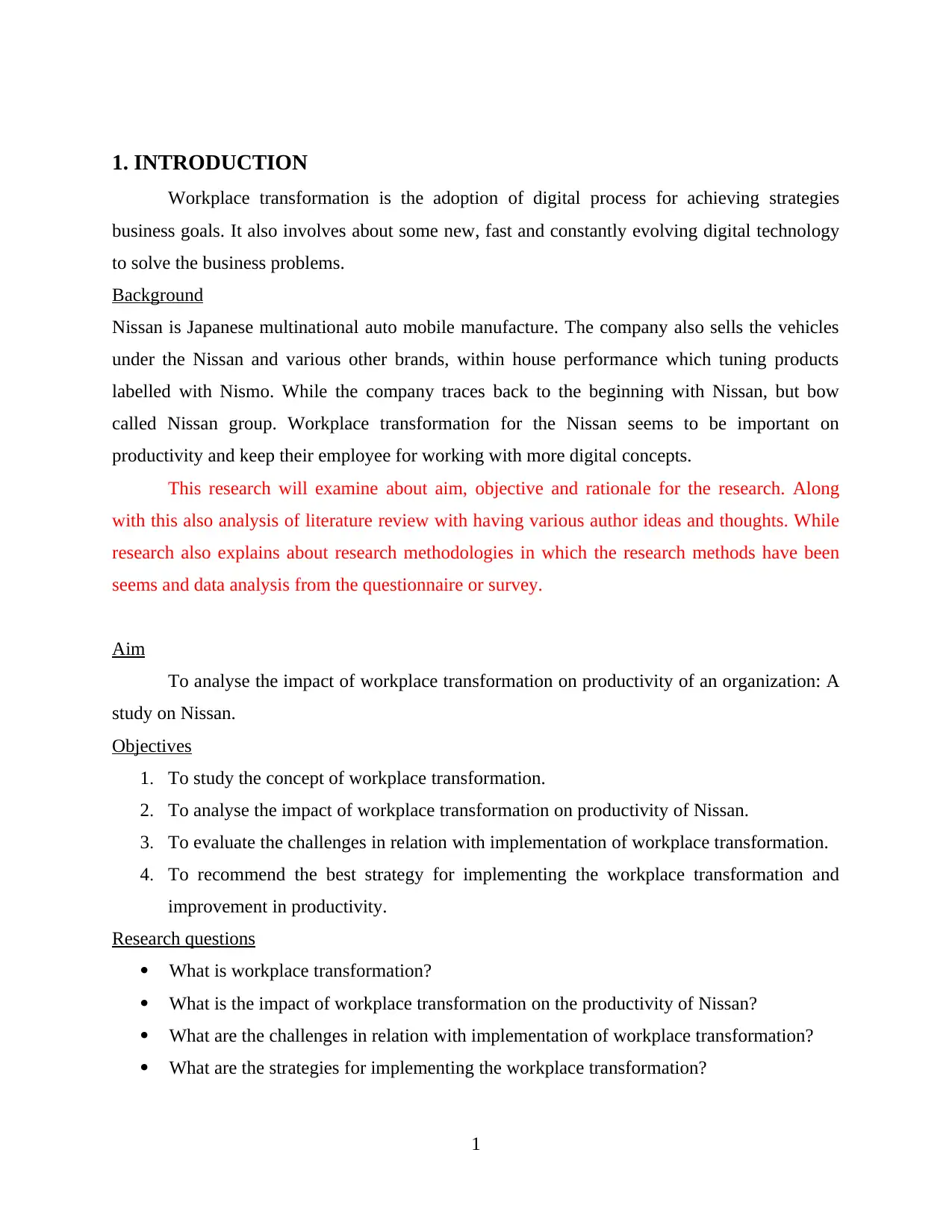
1. INTRODUCTION
Workplace transformation is the adoption of digital process for achieving strategies
business goals. It also involves about some new, fast and constantly evolving digital technology
to solve the business problems.
Background
Nissan is Japanese multinational auto mobile manufacture. The company also sells the vehicles
under the Nissan and various other brands, within house performance which tuning products
labelled with Nismo. While the company traces back to the beginning with Nissan, but bow
called Nissan group. Workplace transformation for the Nissan seems to be important on
productivity and keep their employee for working with more digital concepts.
This research will examine about aim, objective and rationale for the research. Along
with this also analysis of literature review with having various author ideas and thoughts. While
research also explains about research methodologies in which the research methods have been
seems and data analysis from the questionnaire or survey.
Aim
To analyse the impact of workplace transformation on productivity of an organization: A
study on Nissan.
Objectives
1. To study the concept of workplace transformation.
2. To analyse the impact of workplace transformation on productivity of Nissan.
3. To evaluate the challenges in relation with implementation of workplace transformation.
4. To recommend the best strategy for implementing the workplace transformation and
improvement in productivity.
Research questions
What is workplace transformation?
What is the impact of workplace transformation on the productivity of Nissan?
What are the challenges in relation with implementation of workplace transformation?
What are the strategies for implementing the workplace transformation?
1
Workplace transformation is the adoption of digital process for achieving strategies
business goals. It also involves about some new, fast and constantly evolving digital technology
to solve the business problems.
Background
Nissan is Japanese multinational auto mobile manufacture. The company also sells the vehicles
under the Nissan and various other brands, within house performance which tuning products
labelled with Nismo. While the company traces back to the beginning with Nissan, but bow
called Nissan group. Workplace transformation for the Nissan seems to be important on
productivity and keep their employee for working with more digital concepts.
This research will examine about aim, objective and rationale for the research. Along
with this also analysis of literature review with having various author ideas and thoughts. While
research also explains about research methodologies in which the research methods have been
seems and data analysis from the questionnaire or survey.
Aim
To analyse the impact of workplace transformation on productivity of an organization: A
study on Nissan.
Objectives
1. To study the concept of workplace transformation.
2. To analyse the impact of workplace transformation on productivity of Nissan.
3. To evaluate the challenges in relation with implementation of workplace transformation.
4. To recommend the best strategy for implementing the workplace transformation and
improvement in productivity.
Research questions
What is workplace transformation?
What is the impact of workplace transformation on the productivity of Nissan?
What are the challenges in relation with implementation of workplace transformation?
What are the strategies for implementing the workplace transformation?
1
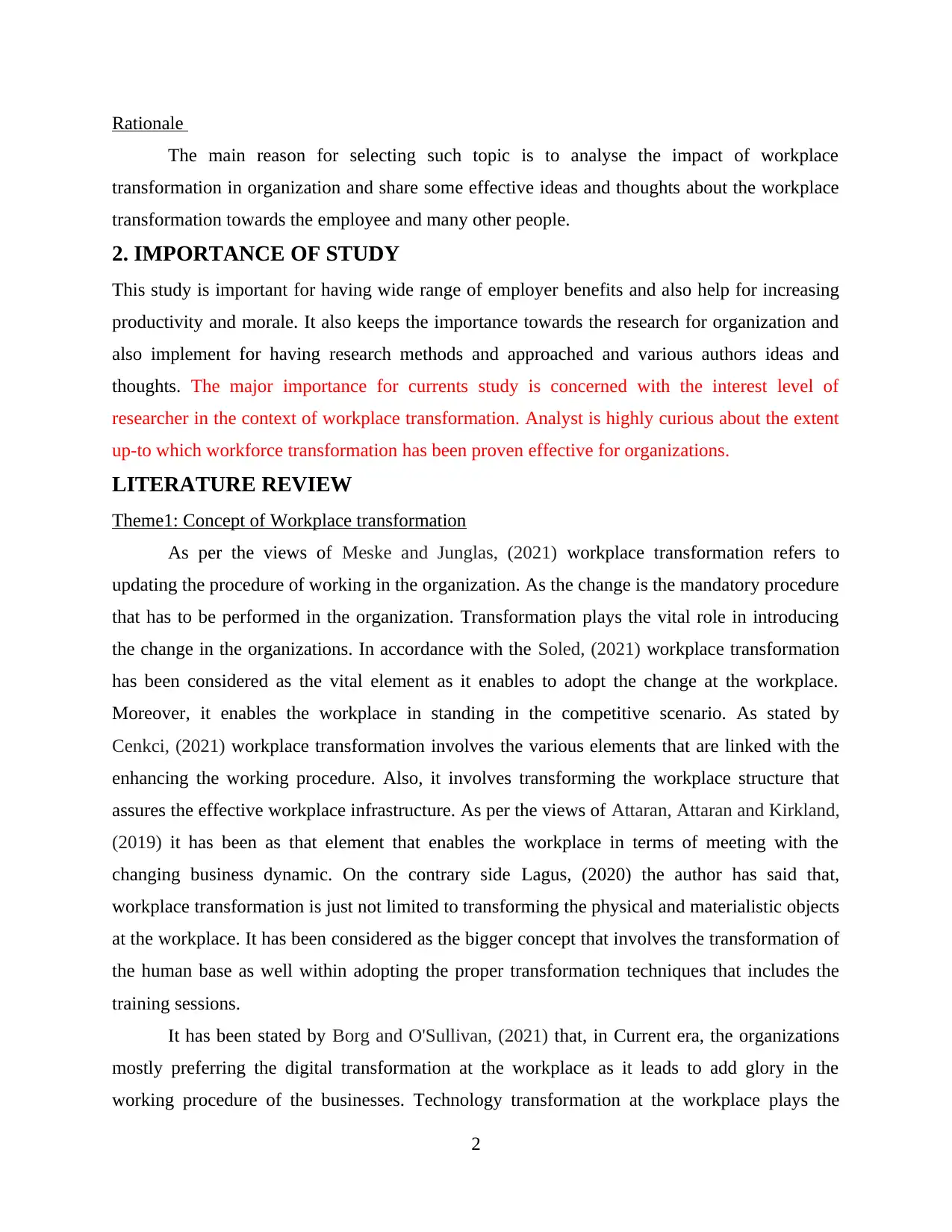
Rationale
The main reason for selecting such topic is to analyse the impact of workplace
transformation in organization and share some effective ideas and thoughts about the workplace
transformation towards the employee and many other people.
2. IMPORTANCE OF STUDY
This study is important for having wide range of employer benefits and also help for increasing
productivity and morale. It also keeps the importance towards the research for organization and
also implement for having research methods and approached and various authors ideas and
thoughts. The major importance for currents study is concerned with the interest level of
researcher in the context of workplace transformation. Analyst is highly curious about the extent
up-to which workforce transformation has been proven effective for organizations.
LITERATURE REVIEW
Theme1: Concept of Workplace transformation
As per the views of Meske and Junglas, (2021) workplace transformation refers to
updating the procedure of working in the organization. As the change is the mandatory procedure
that has to be performed in the organization. Transformation plays the vital role in introducing
the change in the organizations. In accordance with the Soled, (2021) workplace transformation
has been considered as the vital element as it enables to adopt the change at the workplace.
Moreover, it enables the workplace in standing in the competitive scenario. As stated by
Cenkci, (2021) workplace transformation involves the various elements that are linked with the
enhancing the working procedure. Also, it involves transforming the workplace structure that
assures the effective workplace infrastructure. As per the views of Attaran, Attaran and Kirkland,
(2019) it has been as that element that enables the workplace in terms of meeting with the
changing business dynamic. On the contrary side Lagus, (2020) the author has said that,
workplace transformation is just not limited to transforming the physical and materialistic objects
at the workplace. It has been considered as the bigger concept that involves the transformation of
the human base as well within adopting the proper transformation techniques that includes the
training sessions.
It has been stated by Borg and O'Sullivan, (2021) that, in Current era, the organizations
mostly preferring the digital transformation at the workplace as it leads to add glory in the
working procedure of the businesses. Technology transformation at the workplace plays the
2
The main reason for selecting such topic is to analyse the impact of workplace
transformation in organization and share some effective ideas and thoughts about the workplace
transformation towards the employee and many other people.
2. IMPORTANCE OF STUDY
This study is important for having wide range of employer benefits and also help for increasing
productivity and morale. It also keeps the importance towards the research for organization and
also implement for having research methods and approached and various authors ideas and
thoughts. The major importance for currents study is concerned with the interest level of
researcher in the context of workplace transformation. Analyst is highly curious about the extent
up-to which workforce transformation has been proven effective for organizations.
LITERATURE REVIEW
Theme1: Concept of Workplace transformation
As per the views of Meske and Junglas, (2021) workplace transformation refers to
updating the procedure of working in the organization. As the change is the mandatory procedure
that has to be performed in the organization. Transformation plays the vital role in introducing
the change in the organizations. In accordance with the Soled, (2021) workplace transformation
has been considered as the vital element as it enables to adopt the change at the workplace.
Moreover, it enables the workplace in standing in the competitive scenario. As stated by
Cenkci, (2021) workplace transformation involves the various elements that are linked with the
enhancing the working procedure. Also, it involves transforming the workplace structure that
assures the effective workplace infrastructure. As per the views of Attaran, Attaran and Kirkland,
(2019) it has been as that element that enables the workplace in terms of meeting with the
changing business dynamic. On the contrary side Lagus, (2020) the author has said that,
workplace transformation is just not limited to transforming the physical and materialistic objects
at the workplace. It has been considered as the bigger concept that involves the transformation of
the human base as well within adopting the proper transformation techniques that includes the
training sessions.
It has been stated by Borg and O'Sullivan, (2021) that, in Current era, the organizations
mostly preferring the digital transformation at the workplace as it leads to add glory in the
working procedure of the businesses. Technology transformation at the workplace plays the
2
⊘ This is a preview!⊘
Do you want full access?
Subscribe today to unlock all pages.

Trusted by 1+ million students worldwide
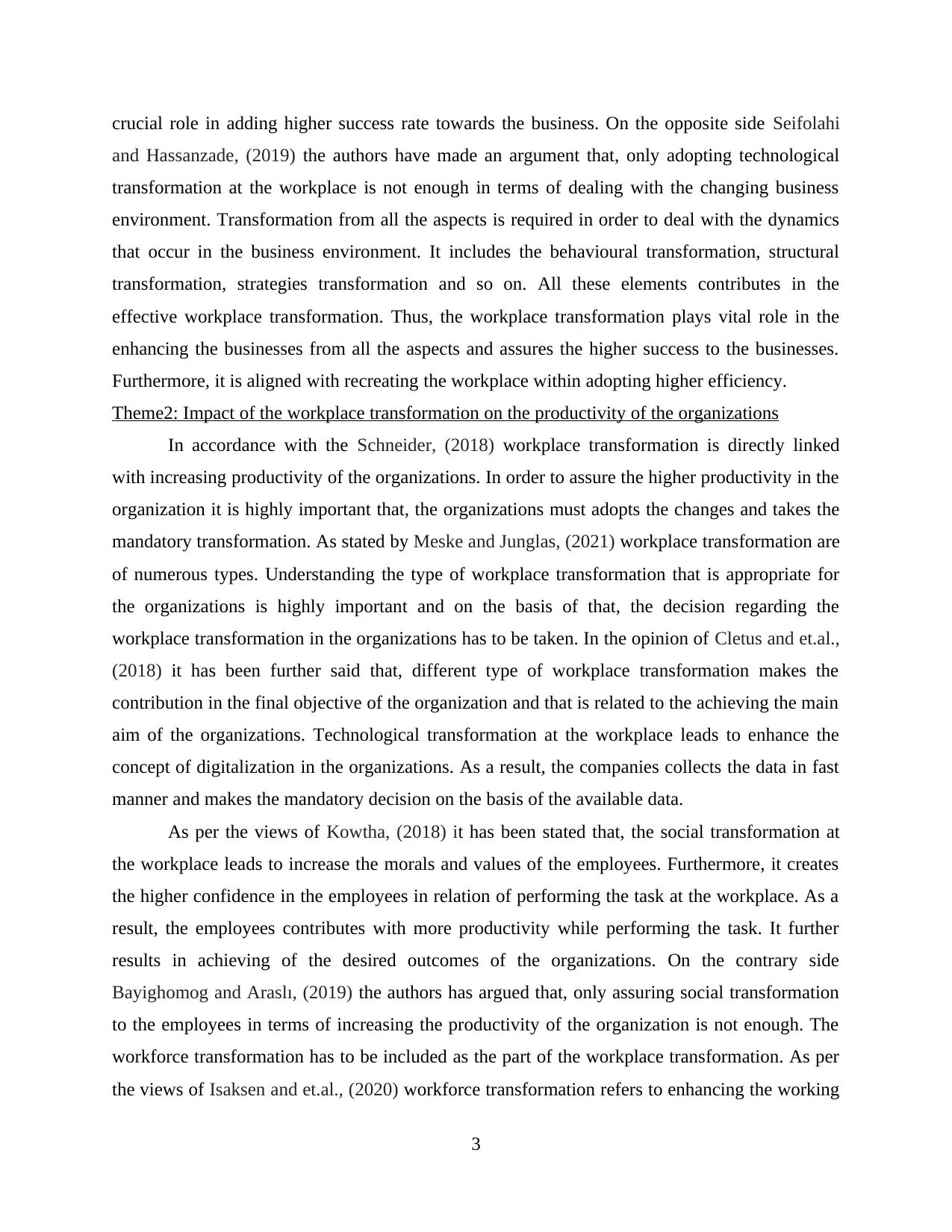
crucial role in adding higher success rate towards the business. On the opposite side Seifolahi
and Hassanzade, (2019) the authors have made an argument that, only adopting technological
transformation at the workplace is not enough in terms of dealing with the changing business
environment. Transformation from all the aspects is required in order to deal with the dynamics
that occur in the business environment. It includes the behavioural transformation, structural
transformation, strategies transformation and so on. All these elements contributes in the
effective workplace transformation. Thus, the workplace transformation plays vital role in the
enhancing the businesses from all the aspects and assures the higher success to the businesses.
Furthermore, it is aligned with recreating the workplace within adopting higher efficiency.
Theme2: Impact of the workplace transformation on the productivity of the organizations
In accordance with the Schneider, (2018) workplace transformation is directly linked
with increasing productivity of the organizations. In order to assure the higher productivity in the
organization it is highly important that, the organizations must adopts the changes and takes the
mandatory transformation. As stated by Meske and Junglas, (2021) workplace transformation are
of numerous types. Understanding the type of workplace transformation that is appropriate for
the organizations is highly important and on the basis of that, the decision regarding the
workplace transformation in the organizations has to be taken. In the opinion of Cletus and et.al.,
(2018) it has been further said that, different type of workplace transformation makes the
contribution in the final objective of the organization and that is related to the achieving the main
aim of the organizations. Technological transformation at the workplace leads to enhance the
concept of digitalization in the organizations. As a result, the companies collects the data in fast
manner and makes the mandatory decision on the basis of the available data.
As per the views of Kowtha, (2018) it has been stated that, the social transformation at
the workplace leads to increase the morals and values of the employees. Furthermore, it creates
the higher confidence in the employees in relation of performing the task at the workplace. As a
result, the employees contributes with more productivity while performing the task. It further
results in achieving of the desired outcomes of the organizations. On the contrary side
Bayighomog and Araslı, (2019) the authors has argued that, only assuring social transformation
to the employees in terms of increasing the productivity of the organization is not enough. The
workforce transformation has to be included as the part of the workplace transformation. As per
the views of Isaksen and et.al., (2020) workforce transformation refers to enhancing the working
3
and Hassanzade, (2019) the authors have made an argument that, only adopting technological
transformation at the workplace is not enough in terms of dealing with the changing business
environment. Transformation from all the aspects is required in order to deal with the dynamics
that occur in the business environment. It includes the behavioural transformation, structural
transformation, strategies transformation and so on. All these elements contributes in the
effective workplace transformation. Thus, the workplace transformation plays vital role in the
enhancing the businesses from all the aspects and assures the higher success to the businesses.
Furthermore, it is aligned with recreating the workplace within adopting higher efficiency.
Theme2: Impact of the workplace transformation on the productivity of the organizations
In accordance with the Schneider, (2018) workplace transformation is directly linked
with increasing productivity of the organizations. In order to assure the higher productivity in the
organization it is highly important that, the organizations must adopts the changes and takes the
mandatory transformation. As stated by Meske and Junglas, (2021) workplace transformation are
of numerous types. Understanding the type of workplace transformation that is appropriate for
the organizations is highly important and on the basis of that, the decision regarding the
workplace transformation in the organizations has to be taken. In the opinion of Cletus and et.al.,
(2018) it has been further said that, different type of workplace transformation makes the
contribution in the final objective of the organization and that is related to the achieving the main
aim of the organizations. Technological transformation at the workplace leads to enhance the
concept of digitalization in the organizations. As a result, the companies collects the data in fast
manner and makes the mandatory decision on the basis of the available data.
As per the views of Kowtha, (2018) it has been stated that, the social transformation at
the workplace leads to increase the morals and values of the employees. Furthermore, it creates
the higher confidence in the employees in relation of performing the task at the workplace. As a
result, the employees contributes with more productivity while performing the task. It further
results in achieving of the desired outcomes of the organizations. On the contrary side
Bayighomog and Araslı, (2019) the authors has argued that, only assuring social transformation
to the employees in terms of increasing the productivity of the organization is not enough. The
workforce transformation has to be included as the part of the workplace transformation. As per
the views of Isaksen and et.al., (2020) workforce transformation refers to enhancing the working
3
Paraphrase This Document
Need a fresh take? Get an instant paraphrase of this document with our AI Paraphraser
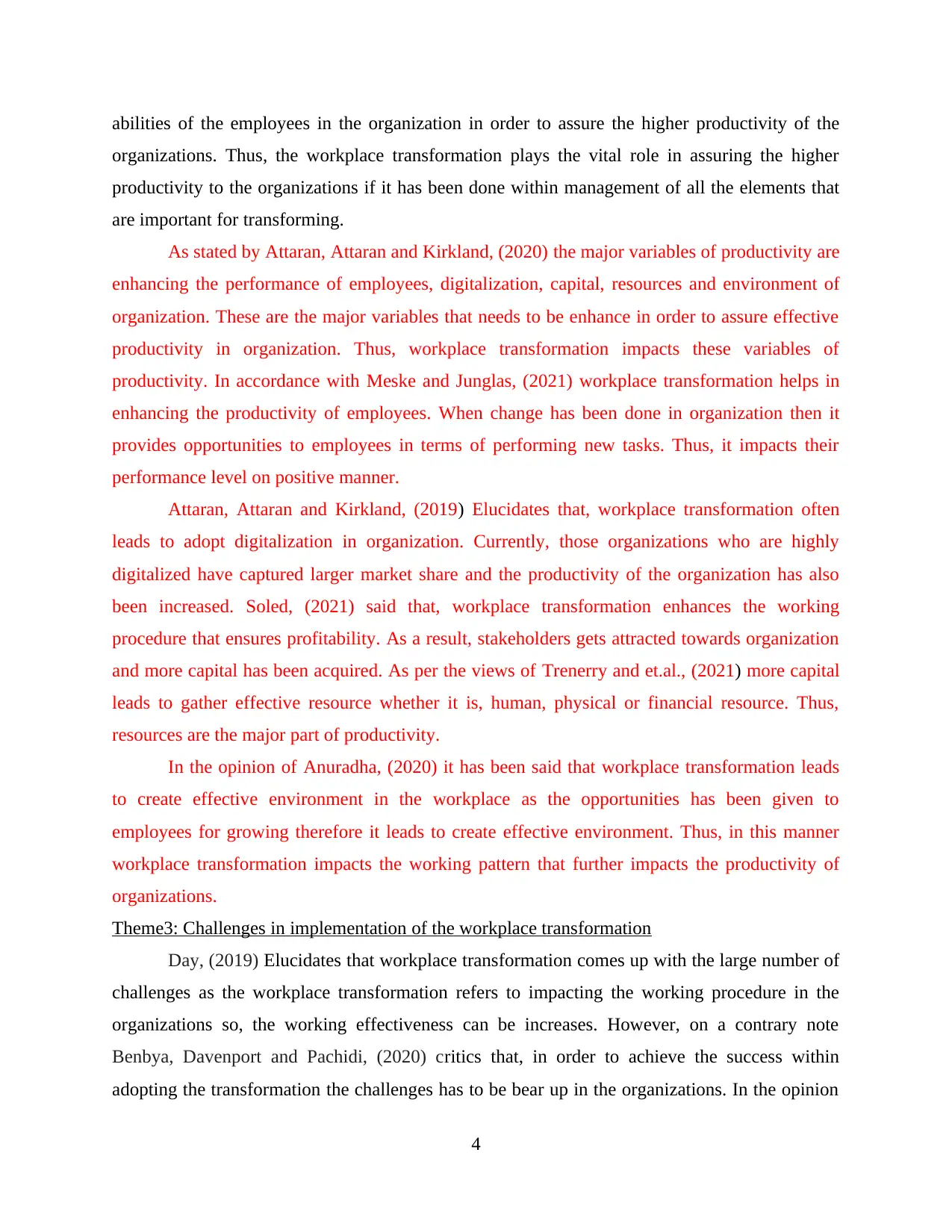
abilities of the employees in the organization in order to assure the higher productivity of the
organizations. Thus, the workplace transformation plays the vital role in assuring the higher
productivity to the organizations if it has been done within management of all the elements that
are important for transforming.
As stated by Attaran, Attaran and Kirkland, (2020) the major variables of productivity are
enhancing the performance of employees, digitalization, capital, resources and environment of
organization. These are the major variables that needs to be enhance in order to assure effective
productivity in organization. Thus, workplace transformation impacts these variables of
productivity. In accordance with Meske and Junglas, (2021) workplace transformation helps in
enhancing the productivity of employees. When change has been done in organization then it
provides opportunities to employees in terms of performing new tasks. Thus, it impacts their
performance level on positive manner.
Attaran, Attaran and Kirkland, (2019) Elucidates that, workplace transformation often
leads to adopt digitalization in organization. Currently, those organizations who are highly
digitalized have captured larger market share and the productivity of the organization has also
been increased. Soled, (2021) said that, workplace transformation enhances the working
procedure that ensures profitability. As a result, stakeholders gets attracted towards organization
and more capital has been acquired. As per the views of Trenerry and et.al., (2021) more capital
leads to gather effective resource whether it is, human, physical or financial resource. Thus,
resources are the major part of productivity.
In the opinion of Anuradha, (2020) it has been said that workplace transformation leads
to create effective environment in the workplace as the opportunities has been given to
employees for growing therefore it leads to create effective environment. Thus, in this manner
workplace transformation impacts the working pattern that further impacts the productivity of
organizations.
Theme3: Challenges in implementation of the workplace transformation
Day, (2019) Elucidates that workplace transformation comes up with the large number of
challenges as the workplace transformation refers to impacting the working procedure in the
organizations so, the working effectiveness can be increases. However, on a contrary note
Benbya, Davenport and Pachidi, (2020) critics that, in order to achieve the success within
adopting the transformation the challenges has to be bear up in the organizations. In the opinion
4
organizations. Thus, the workplace transformation plays the vital role in assuring the higher
productivity to the organizations if it has been done within management of all the elements that
are important for transforming.
As stated by Attaran, Attaran and Kirkland, (2020) the major variables of productivity are
enhancing the performance of employees, digitalization, capital, resources and environment of
organization. These are the major variables that needs to be enhance in order to assure effective
productivity in organization. Thus, workplace transformation impacts these variables of
productivity. In accordance with Meske and Junglas, (2021) workplace transformation helps in
enhancing the productivity of employees. When change has been done in organization then it
provides opportunities to employees in terms of performing new tasks. Thus, it impacts their
performance level on positive manner.
Attaran, Attaran and Kirkland, (2019) Elucidates that, workplace transformation often
leads to adopt digitalization in organization. Currently, those organizations who are highly
digitalized have captured larger market share and the productivity of the organization has also
been increased. Soled, (2021) said that, workplace transformation enhances the working
procedure that ensures profitability. As a result, stakeholders gets attracted towards organization
and more capital has been acquired. As per the views of Trenerry and et.al., (2021) more capital
leads to gather effective resource whether it is, human, physical or financial resource. Thus,
resources are the major part of productivity.
In the opinion of Anuradha, (2020) it has been said that workplace transformation leads
to create effective environment in the workplace as the opportunities has been given to
employees for growing therefore it leads to create effective environment. Thus, in this manner
workplace transformation impacts the working pattern that further impacts the productivity of
organizations.
Theme3: Challenges in implementation of the workplace transformation
Day, (2019) Elucidates that workplace transformation comes up with the large number of
challenges as the workplace transformation refers to impacting the working procedure in the
organizations so, the working effectiveness can be increases. However, on a contrary note
Benbya, Davenport and Pachidi, (2020) critics that, in order to achieve the success within
adopting the transformation the challenges has to be bear up in the organizations. In the opinion
4
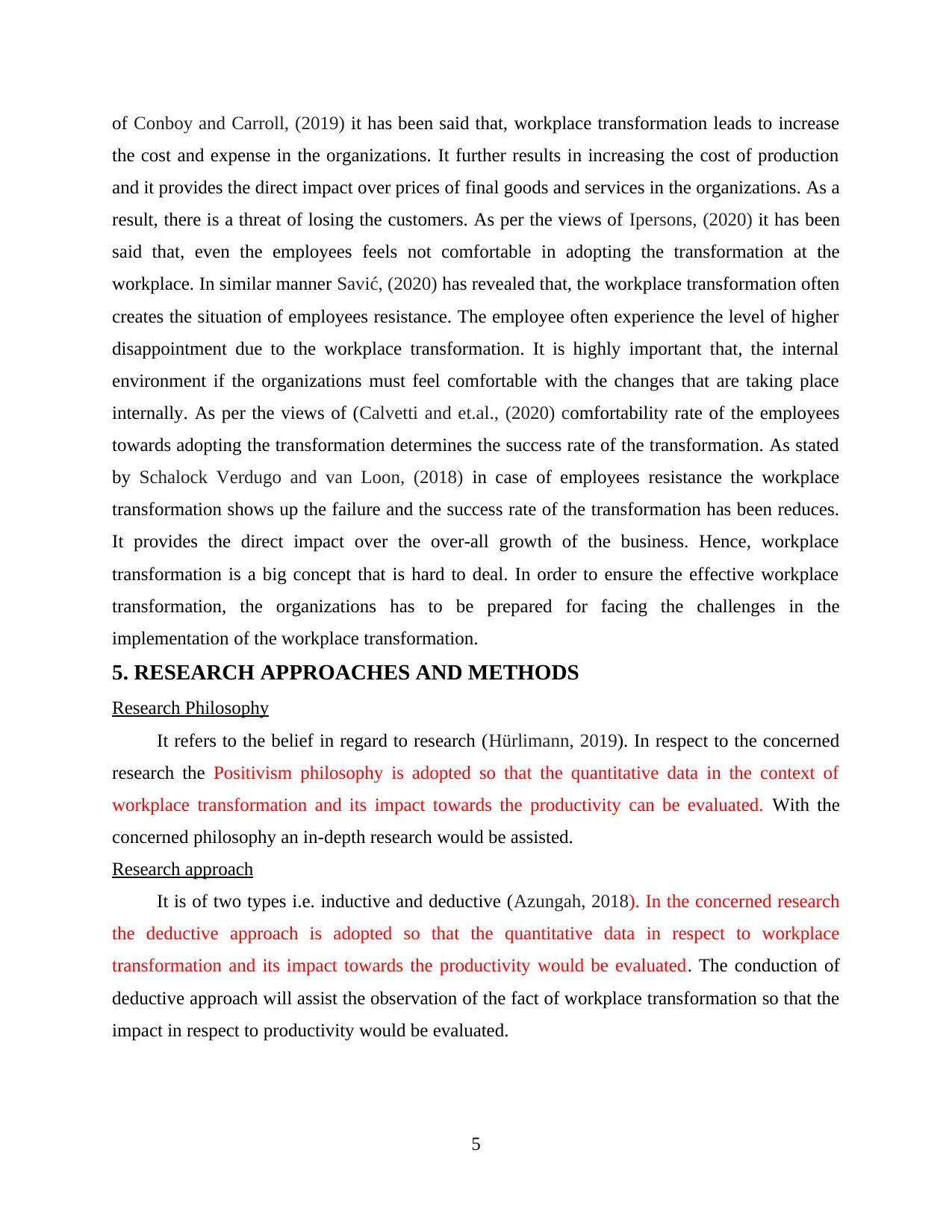
of Conboy and Carroll, (2019) it has been said that, workplace transformation leads to increase
the cost and expense in the organizations. It further results in increasing the cost of production
and it provides the direct impact over prices of final goods and services in the organizations. As a
result, there is a threat of losing the customers. As per the views of Ipersons, (2020) it has been
said that, even the employees feels not comfortable in adopting the transformation at the
workplace. In similar manner Savić, (2020) has revealed that, the workplace transformation often
creates the situation of employees resistance. The employee often experience the level of higher
disappointment due to the workplace transformation. It is highly important that, the internal
environment if the organizations must feel comfortable with the changes that are taking place
internally. As per the views of (Calvetti and et.al., (2020) comfortability rate of the employees
towards adopting the transformation determines the success rate of the transformation. As stated
by Schalock Verdugo and van Loon, (2018) in case of employees resistance the workplace
transformation shows up the failure and the success rate of the transformation has been reduces.
It provides the direct impact over the over-all growth of the business. Hence, workplace
transformation is a big concept that is hard to deal. In order to ensure the effective workplace
transformation, the organizations has to be prepared for facing the challenges in the
implementation of the workplace transformation.
5. RESEARCH APPROACHES AND METHODS
Research Philosophy
It refers to the belief in regard to research (Hürlimann, 2019). In respect to the concerned
research the Positivism philosophy is adopted so that the quantitative data in the context of
workplace transformation and its impact towards the productivity can be evaluated. With the
concerned philosophy an in-depth research would be assisted.
Research approach
It is of two types i.e. inductive and deductive (Azungah, 2018). In the concerned research
the deductive approach is adopted so that the quantitative data in respect to workplace
transformation and its impact towards the productivity would be evaluated. The conduction of
deductive approach will assist the observation of the fact of workplace transformation so that the
impact in respect to productivity would be evaluated.
5
the cost and expense in the organizations. It further results in increasing the cost of production
and it provides the direct impact over prices of final goods and services in the organizations. As a
result, there is a threat of losing the customers. As per the views of Ipersons, (2020) it has been
said that, even the employees feels not comfortable in adopting the transformation at the
workplace. In similar manner Savić, (2020) has revealed that, the workplace transformation often
creates the situation of employees resistance. The employee often experience the level of higher
disappointment due to the workplace transformation. It is highly important that, the internal
environment if the organizations must feel comfortable with the changes that are taking place
internally. As per the views of (Calvetti and et.al., (2020) comfortability rate of the employees
towards adopting the transformation determines the success rate of the transformation. As stated
by Schalock Verdugo and van Loon, (2018) in case of employees resistance the workplace
transformation shows up the failure and the success rate of the transformation has been reduces.
It provides the direct impact over the over-all growth of the business. Hence, workplace
transformation is a big concept that is hard to deal. In order to ensure the effective workplace
transformation, the organizations has to be prepared for facing the challenges in the
implementation of the workplace transformation.
5. RESEARCH APPROACHES AND METHODS
Research Philosophy
It refers to the belief in regard to research (Hürlimann, 2019). In respect to the concerned
research the Positivism philosophy is adopted so that the quantitative data in the context of
workplace transformation and its impact towards the productivity can be evaluated. With the
concerned philosophy an in-depth research would be assisted.
Research approach
It is of two types i.e. inductive and deductive (Azungah, 2018). In the concerned research
the deductive approach is adopted so that the quantitative data in respect to workplace
transformation and its impact towards the productivity would be evaluated. The conduction of
deductive approach will assist the observation of the fact of workplace transformation so that the
impact in respect to productivity would be evaluated.
5
⊘ This is a preview!⊘
Do you want full access?
Subscribe today to unlock all pages.

Trusted by 1+ million students worldwide
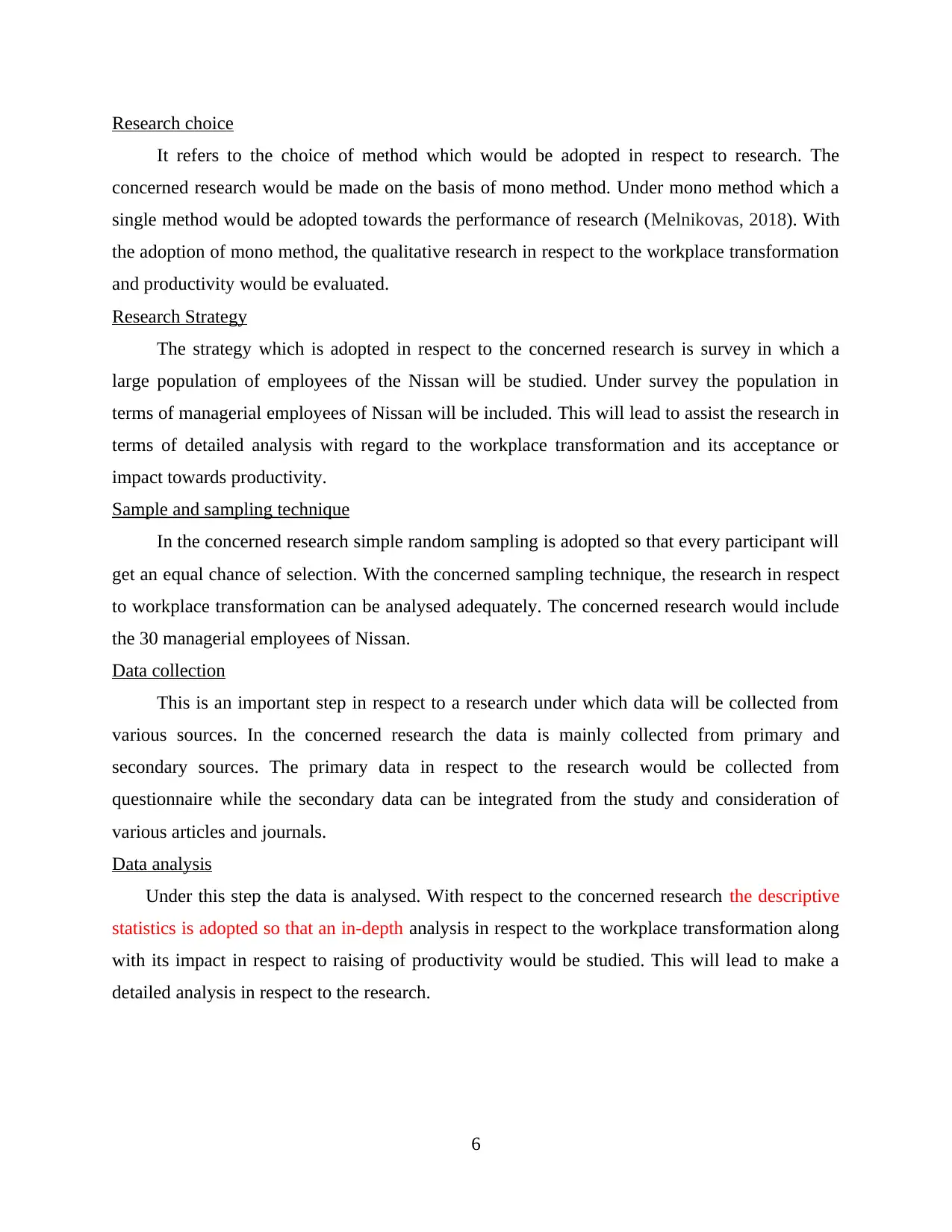
Research choice
It refers to the choice of method which would be adopted in respect to research. The
concerned research would be made on the basis of mono method. Under mono method which a
single method would be adopted towards the performance of research (Melnikovas, 2018). With
the adoption of mono method, the qualitative research in respect to the workplace transformation
and productivity would be evaluated.
Research Strategy
The strategy which is adopted in respect to the concerned research is survey in which a
large population of employees of the Nissan will be studied. Under survey the population in
terms of managerial employees of Nissan will be included. This will lead to assist the research in
terms of detailed analysis with regard to the workplace transformation and its acceptance or
impact towards productivity.
Sample and sampling technique
In the concerned research simple random sampling is adopted so that every participant will
get an equal chance of selection. With the concerned sampling technique, the research in respect
to workplace transformation can be analysed adequately. The concerned research would include
the 30 managerial employees of Nissan.
Data collection
This is an important step in respect to a research under which data will be collected from
various sources. In the concerned research the data is mainly collected from primary and
secondary sources. The primary data in respect to the research would be collected from
questionnaire while the secondary data can be integrated from the study and consideration of
various articles and journals.
Data analysis
Under this step the data is analysed. With respect to the concerned research the descriptive
statistics is adopted so that an in-depth analysis in respect to the workplace transformation along
with its impact in respect to raising of productivity would be studied. This will lead to make a
detailed analysis in respect to the research.
6
It refers to the choice of method which would be adopted in respect to research. The
concerned research would be made on the basis of mono method. Under mono method which a
single method would be adopted towards the performance of research (Melnikovas, 2018). With
the adoption of mono method, the qualitative research in respect to the workplace transformation
and productivity would be evaluated.
Research Strategy
The strategy which is adopted in respect to the concerned research is survey in which a
large population of employees of the Nissan will be studied. Under survey the population in
terms of managerial employees of Nissan will be included. This will lead to assist the research in
terms of detailed analysis with regard to the workplace transformation and its acceptance or
impact towards productivity.
Sample and sampling technique
In the concerned research simple random sampling is adopted so that every participant will
get an equal chance of selection. With the concerned sampling technique, the research in respect
to workplace transformation can be analysed adequately. The concerned research would include
the 30 managerial employees of Nissan.
Data collection
This is an important step in respect to a research under which data will be collected from
various sources. In the concerned research the data is mainly collected from primary and
secondary sources. The primary data in respect to the research would be collected from
questionnaire while the secondary data can be integrated from the study and consideration of
various articles and journals.
Data analysis
Under this step the data is analysed. With respect to the concerned research the descriptive
statistics is adopted so that an in-depth analysis in respect to the workplace transformation along
with its impact in respect to raising of productivity would be studied. This will lead to make a
detailed analysis in respect to the research.
6
Paraphrase This Document
Need a fresh take? Get an instant paraphrase of this document with our AI Paraphraser
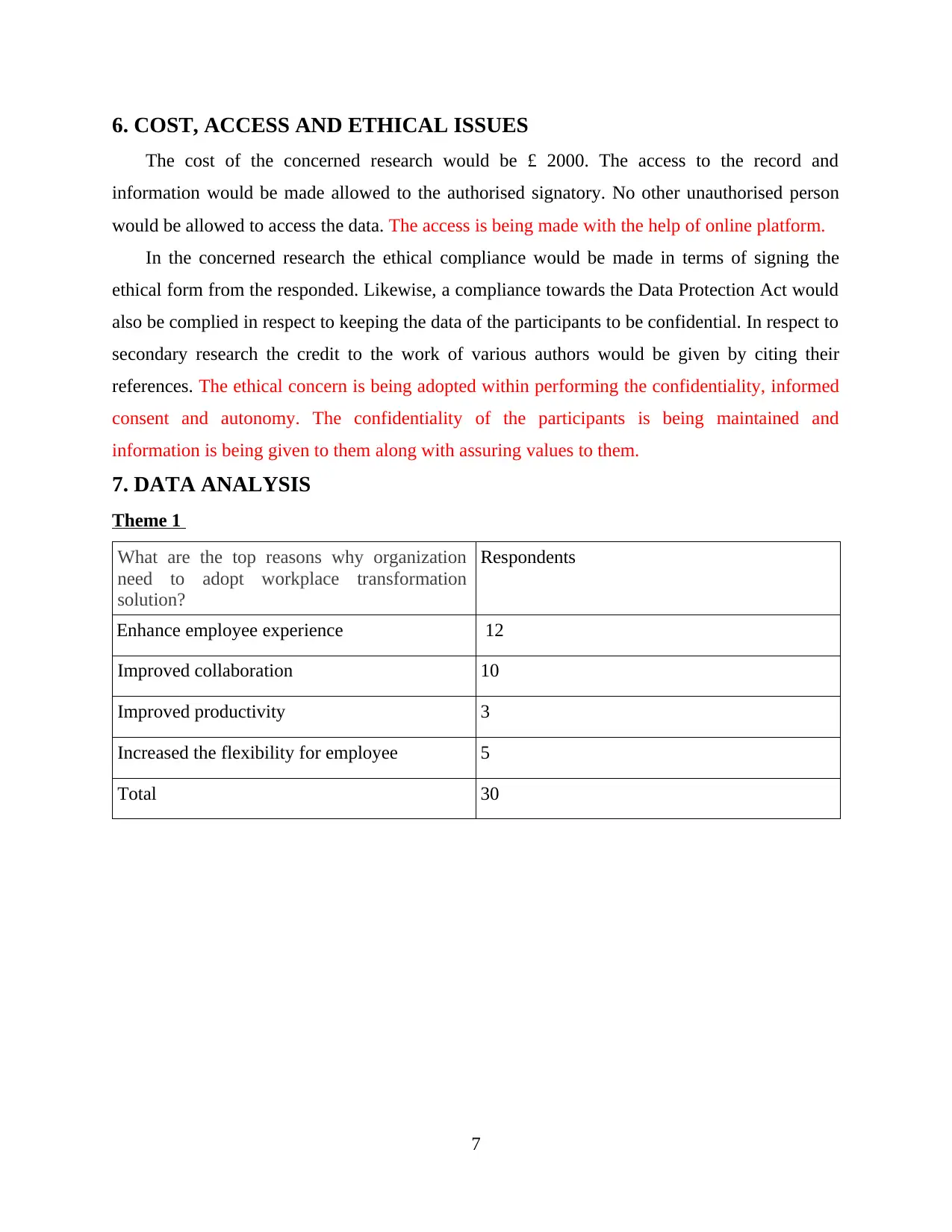
6. COST, ACCESS AND ETHICAL ISSUES
The cost of the concerned research would be £ 2000. The access to the record and
information would be made allowed to the authorised signatory. No other unauthorised person
would be allowed to access the data. The access is being made with the help of online platform.
In the concerned research the ethical compliance would be made in terms of signing the
ethical form from the responded. Likewise, a compliance towards the Data Protection Act would
also be complied in respect to keeping the data of the participants to be confidential. In respect to
secondary research the credit to the work of various authors would be given by citing their
references. The ethical concern is being adopted within performing the confidentiality, informed
consent and autonomy. The confidentiality of the participants is being maintained and
information is being given to them along with assuring values to them.
7. DATA ANALYSIS
Theme 1
What are the top reasons why organization
need to adopt workplace transformation
solution?
Respondents
Enhance employee experience 12
Improved collaboration 10
Improved productivity 3
Increased the flexibility for employee 5
Total 30
7
The cost of the concerned research would be £ 2000. The access to the record and
information would be made allowed to the authorised signatory. No other unauthorised person
would be allowed to access the data. The access is being made with the help of online platform.
In the concerned research the ethical compliance would be made in terms of signing the
ethical form from the responded. Likewise, a compliance towards the Data Protection Act would
also be complied in respect to keeping the data of the participants to be confidential. In respect to
secondary research the credit to the work of various authors would be given by citing their
references. The ethical concern is being adopted within performing the confidentiality, informed
consent and autonomy. The confidentiality of the participants is being maintained and
information is being given to them along with assuring values to them.
7. DATA ANALYSIS
Theme 1
What are the top reasons why organization
need to adopt workplace transformation
solution?
Respondents
Enhance employee experience 12
Improved collaboration 10
Improved productivity 3
Increased the flexibility for employee 5
Total 30
7
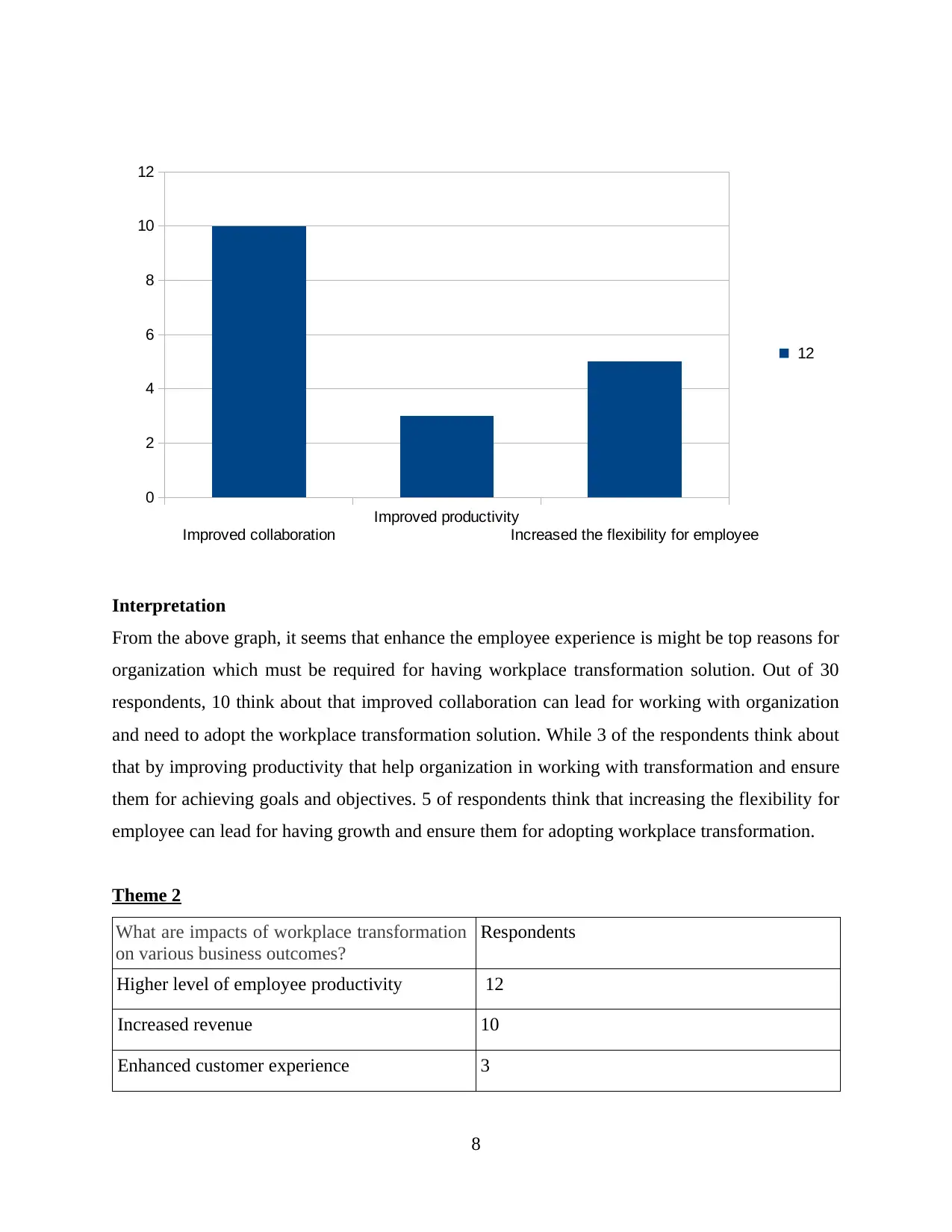
Interpretation
From the above graph, it seems that enhance the employee experience is might be top reasons for
organization which must be required for having workplace transformation solution. Out of 30
respondents, 10 think about that improved collaboration can lead for working with organization
and need to adopt the workplace transformation solution. While 3 of the respondents think about
that by improving productivity that help organization in working with transformation and ensure
them for achieving goals and objectives. 5 of respondents think that increasing the flexibility for
employee can lead for having growth and ensure them for adopting workplace transformation.
Theme 2
What are impacts of workplace transformation
on various business outcomes?
Respondents
Higher level of employee productivity 12
Increased revenue 10
Enhanced customer experience 3
8
Improved collaboration
Improved productivity
Increased the flexibility for employee
0
2
4
6
8
10
12
12
From the above graph, it seems that enhance the employee experience is might be top reasons for
organization which must be required for having workplace transformation solution. Out of 30
respondents, 10 think about that improved collaboration can lead for working with organization
and need to adopt the workplace transformation solution. While 3 of the respondents think about
that by improving productivity that help organization in working with transformation and ensure
them for achieving goals and objectives. 5 of respondents think that increasing the flexibility for
employee can lead for having growth and ensure them for adopting workplace transformation.
Theme 2
What are impacts of workplace transformation
on various business outcomes?
Respondents
Higher level of employee productivity 12
Increased revenue 10
Enhanced customer experience 3
8
Improved collaboration
Improved productivity
Increased the flexibility for employee
0
2
4
6
8
10
12
12
⊘ This is a preview!⊘
Do you want full access?
Subscribe today to unlock all pages.

Trusted by 1+ million students worldwide
1 out of 32
Related Documents
Your All-in-One AI-Powered Toolkit for Academic Success.
+13062052269
info@desklib.com
Available 24*7 on WhatsApp / Email
![[object Object]](/_next/static/media/star-bottom.7253800d.svg)
Unlock your academic potential
Copyright © 2020–2025 A2Z Services. All Rights Reserved. Developed and managed by ZUCOL.




